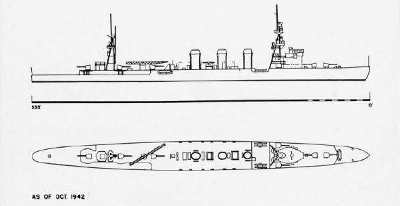![]() The Pacific War Online Encyclopedia
The Pacific War Online Encyclopedia
|
| Previous: Kula Gulf | Table of Contents | Next: Kumagaya |
 ONI 41-42 |  U.S. Navy |
|
Tonnage |
5832 tons
standard displacement |
|
Dimensions |
532' by 46'6" by
16'9" |
|
Maximum speed |
36 knots |
|
Complement |
439 |
|
1 Model 1 or Model 3 catapult |
|
|
Armament |
7x1 5"/50
dual-purpose
guns 2x2 25mm/60 AA guns 4x2 24" torpedo tubes with one reload 48 Type 1-B mines |
| 238.3 tons 1.5" (38mm) + 1" (25mm) HT machinery belt 1.1" (28mm) HT deck (machinery) 1.8" (45mm) HT deck (magazines) 0.8" (20mm) gun shields 1.5" (38mm) + 0.5" (12mm) HT conning tower |
|
| Machinery |
4-shaft Mitsubishi-Parsons-Gihon geared turbines (90,000 shp) 12 Kampon boilers |
|
Bunkerage |
1260 tons fuel oil |
|
Range |
6000 nautical miles (11,000 km) at 14 knots |
| Modifications |
1943-11: Tama and Kiso landed two single 5" guns in
return for a 1x2 5" mount, 4x3, 6x1 25mm guns, and 2 13mm/76 machine guns. Tama adds Type 21 radar. 1944-6 Tama and Kiso add 1x3, 2x2, 12x1 25mm guns, 5-8 13mm machine guns, and Type 22 radar. Tama adds 2 depth charge racks (36 depth charges) |
The Kumas were
completed in 1920-21 as general-purpose light cruisers, capable of
acting as destroyer squadron
leaders, as escorts or scouts for the battle fleet, or for commerce protection. They were essentially enlarged Tenryus, and subsequent classes of Japanese light cruisers were very similar in specifications. The Kumas were
strongly built and had excellent seakeeping, but their crew
accomodations were cramped, hot, and noisy. The class was
extremely maneuverable, one commander boasting that his ship
“could maneuver on
the crest of a wave.” They were powered by
then-new Mitsubishi-Parsons-Gihon
turbines, which had high-pressure and low-pressure halves that were fed
steam in series for economical cruising and in parallel at maximum
power. Two of the boilers were originally mixed-fired boilers that
could handle either fuel oil or coal, but these had been removed long
before war broke out. Protection was very light at 3.7% of
displacement, being designed against the 4" guns typical of U.S. destroyers of the time.
The main armament was arranged as five single mounts on the
centerline and two single wing mounts. This meant that only six of the
seven guns contributed to the broadside,but it allowed four guns to fire
straight ahead.
The Kumas were badly outdated by the start of the Pacific War. Several redesigns were considered, including conversion to minelayers or training vessels. Two of the class (Oi and Kitakami) were converted to torpedo cruisers before the start of the war and are treated as a separate class.
| Sunk by aircraft 1944-11-13
off Manila |
||
| Torpedoed
1944-10-25 off Luzon by Jallao |
||
| Torpedoed
1944-1-11 off Penang by Tally
Ho! |

|
 | 
|
References
Gogin (2010; accessed 2013-3-12)
Lacroix
and Wells
(1997)
Whitley
(1995)
The Pacific War Online Encyclopedia © 2007, 2009, 2013, 2015 by Kent G. Budge. Index